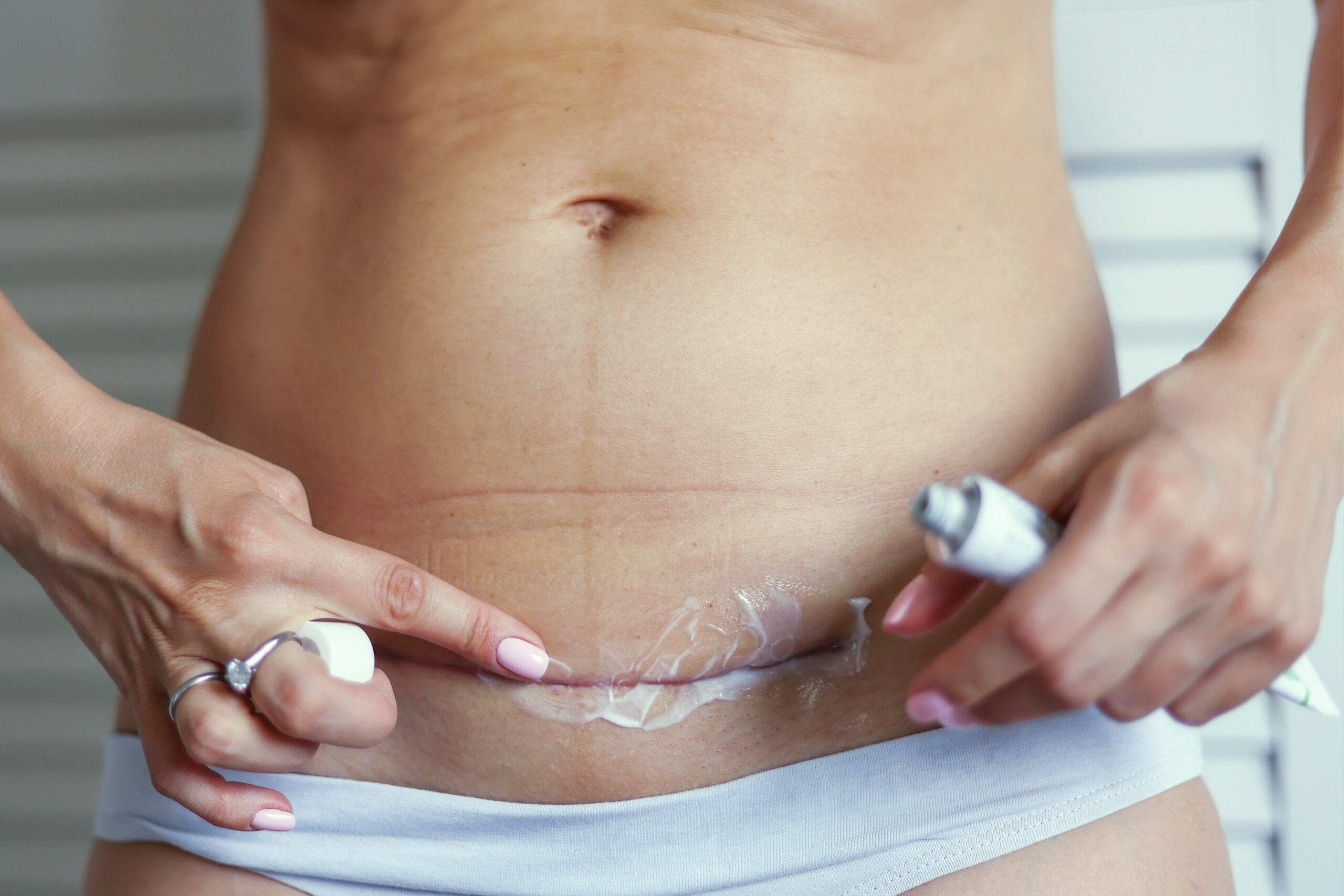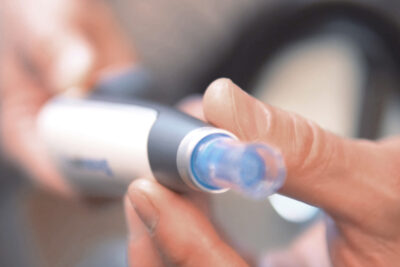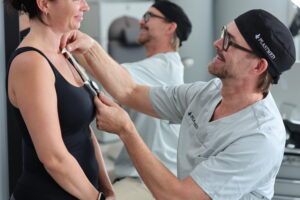A few words on the topic of scar care after surgery
... because a perfect result is also our goal
Natural wound and scar healing is individual to each person. Our gentle suturing techniques and your scar care contribute to the best possible result. We are constantly working to further improve our gentle and modern surgical procedures – for your beauty and safety. We are happy to provide you with information here about optimal scar care after surgery.
Please note that special scar treatments can only take effect if they are used consistently over a longer period of time.
We take the time to address your questions, wishes, and concerns and provide you with transparent information about the opportunities, risks, and possible complications.
Make an appointment now
How do I care for fresh wounds, scars, and skin after a procedure?
After you have been discharged from our treatment and the plasters and bandages have been removed, the scars should be only be showered once a day (using mild, fragrance-free soap or fragrance-free wash lotion) and treated twice a day with a very thin layer of a neutral, oil-based cream (e.g., Bepanthen® wound and healing ointment, Vaseline, neutral, fragrance-free body lotion).
Please cover the wound loosely with a wound dressing and clean compresses from the pharmacy as long as there are still weeping or heavily crusted areas.
Which products are suitable for scar care?
Once your scars have healed and are free of scabs, you can use the following products for scar treatment:
Silicone preparations
To support faster scar maturation, a silicone gel preparation, either as a liquid gel or plaster, can be applied after complete scab-free healing. Silicones inhibit the activity of fibroblasts. These are connective tissue cells that are responsible for scar formation. Silicone preparations promote the formation of soft and flat scars. The use of silicone can even alleviate typical scar symptoms such as itching and pain.
Silicone gel
A silicone gel (e.g., Dermatix-Gel®, available over the counter at pharmacies) is applied twice daily in a very thin layer to the scars and left to dry for a few minutes. The scar gel forms a water-repellent protective film, ensuring optimal moisturization of the wound.
Scar plasters or silicone plasters
Alternatively, a silicone gel patch (e.g., Scarban® or Hansaplast Scar Reduction®) can be cut to the length of the scar and applied. The scar patch is removed for showering and then reapplied to the scars. The same patch can be used for several days. Both preparations can also be prescribed in individual cases. The application period is at least three months, and the treatment must be carried out consistently (at least 12 hours per day) in order to be successful.
Impaired scar development can lead to noticeably thickened, reddened, and highly sensitive scars. Depending on their severity, these are referred to as hypertrophic scars or keloid scars. There are various treatment options, including micro-needling, cortisone injections, or surgical scar correction.
Are scar massages advisable for scar care?
Scar massages after surgical procedures, such as breast augmentation with implants, can have a positive effect on the healing process during the first year after the surgery, as they help to increase the elasticity of the scar.
Scar massage can also loosen or even prevent retraction and adhesion of the skin to the underlying tissue. However, you should only start gentle care, e.g., with Bepanthen® ointment or similar, once the scars have healed completely, i.e., once they are dry and free of scabs (3 weeks after the procedure).
As healing progresses, perform small circular massages with your fingertips 2-3 times a day for 5-10 minutes, applying light pressure along and around the scar. The pressure can be increased as the scar becomes more stable.
Do I need to protect the scars from sunlight or solariums?
During the first year after your surgery, consistently protect unprotected scars from direct sunlight with sunblock and sunscreen to prevent UV-induced discoloration, noticeable scars, and skin damage. Your scar should be protected not only from direct sunlight, but also in solariums.
To do this, use a sunblock or sunscreen with a high sun protection factor (SPF 50+). It is important to reapply the sunscreen repeatedly. Fresh scar tissue is sensitive to direct exposure to the sun and cannot darken like the surrounding skin because there are no melanocytes in the scar.
How long does it take for scars to heal and lighten after surgery?
Once the scar has fully matured, it will usually be soft, pale, and flat. This process can take up to 2 years.
Discomfort or numbness in the area of the scars is usually temporary and improves as the scar matures, usually disappearing completely. In rare cases, however, these symptoms may persist permanently. Unfortunately, this cannot always be avoided surgically.
What should I do if I have a wound healing disorder?
Wound healing disorders (e.g., wound infections, abscesses, or seromas) usually occur within the first few days to weeks and manifest themselves, for example, in increased pain, unusual swelling, redness, fever, or chills, as well as increased or sudden discharge of secretions from the scar or wound.
Please contact us or a co-treating physician immediately if such a wound healing disorder occurs. This can usually be treated effectively, but always requires medical supervision.
Scars itch, burn, or are hardened – what should you do?
If, during the course of scar maturation, there is increased itching, burning, redness of the scars, and an increase and/or hardening of the scar tissue, excessive scar tissue formation (known as hypertrophic scarring or keloids) may be present. The predisposition to form hypertrophic scars and keloids is often genetic and cannot be influenced.
If the scars develop as described above, special treatment is necessary. Please contact us for more information.
Home remedies & Tips for scar care and accelerating wound healing
Your goal with regard to a fresh wound after plastic surgery is surely to achieve an inconspicuous, soft, elastic, flat, pale, and symptom-free scar. Our tips will help you achieve this goal.
- Avoid putting unnecessary tension and pressure on the fresh wound.
- Care for and massage the scars daily with a well-tolerated body care product or scar gel.
- Make sure you eat a balanced diet: vitamins (A, C, E) and trace elements (iron, zinc, and selenium) have a positive effect on wound healing
- Refrain from smoking, as this reduces blood circulation in the tissue.
- Protect fresh wounds and scars from direct sunlight (including solariums) for at least 1 year after the procedure using a high-factor sunscreen.
We will answer your questions in detail during a non-binding initial consultation.
Make an appointment now
„Good scar care is part of the healing process. We will accompany you until you achieve the best possible result.“
 © Stephan Wieland, Düsseldorf
© Stephan Wieland, Düsseldorf Dr. med Louisa Sarica
Specialist in plastic and aesthetic surgeryJameda reviews
These reviews were shared by individuals who rated our services on independent platforms. As some chose to post under pseudonyms, we are currently unable to verify their authenticity.
Behind every number is a person, behind every procedure is a relationship of trust. In over 15 years and numerous surgeries, we have built up experience that today benefits every single patient.
Interested in a consultation?
We offer non-binding consultations—either in person at our clinic or conveniently online via video. Here’s what you can expect:
- Personal consultation with a specialist physician
- Confidential one-on-one setting
- Detailed discussion of your goals, treatment options, and associated costs
- Initial consultation fee: €50
- Optional: Online video consultation available









